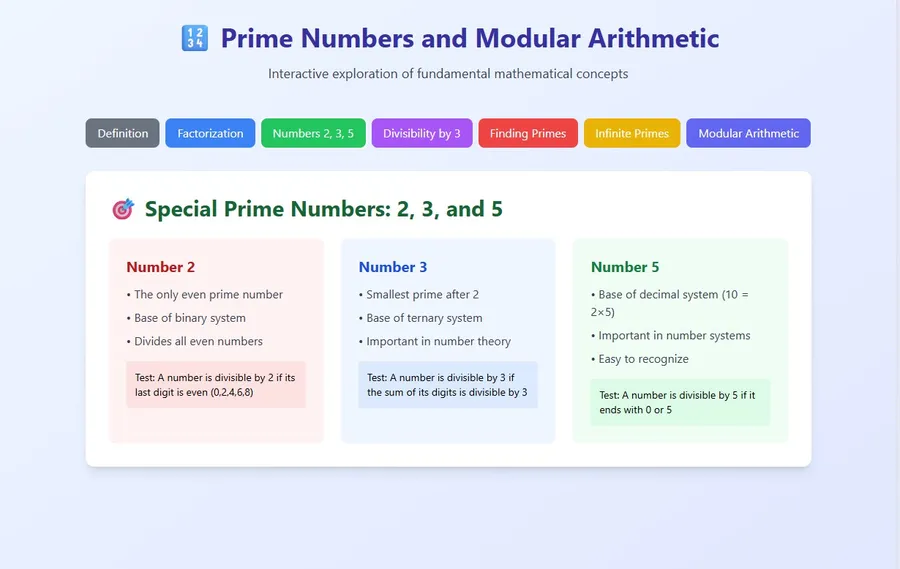Discover the properties, divisibility rules, and examples of numbers 2, 3, and 5. Essential for high school math and prime factorization.
Table Of Contents
Numbers 2, 3, and 5: Properties, Multiples Rules, and Their Role in Mathematics
1. Introduction
Numbers 2, 3, and 5 are the three smallest prime numbers in mathematics. Although simple, each has unique properties and forms the basis of many quick rules (divisibility rules) often used in manual calculations.
These three numbers also frequently appear in prime factorization, GCD/LCM calculations, and number patterns.
2. Number 2
2.1. Unique Properties
- The only even prime number.
- All even numbers are multiples of 2.
- Very important in the concept of parity (odd-even).
2.2. Rule for Multiples of 2
A number is divisible by 2 if its last digit is even (0, 2, 4, 6, or 8).
Example:
- 124 → last digit 4 → divisible by 2.
- 357 → last digit 7 → not divisible by 2.
3. Number 3
3.1. Unique Properties
- The smallest odd prime number.
- The rule for its multiples is related to the sum of its digits.
3.2. Rule for Multiples of 3
A number is divisible by 3 if the sum of all its digits is divisible by 3.
Example:
- 123 → 1+2+3 = 6 → divisible by 3.
- 257 → 2+5+7 = 14 → not divisible by 3.
Brief Proof:
Because , each digit represents itself in mod 3, so the sum of the digits determines divisibility by 3.
4. Number 5
4.1. Unique Properties
- All its multiples end with 0 or 5.
- Very useful for quick divisibility checks.
4.2. Rule for Multiples of 5
A number is divisible by 5 if its last digit is 0 or 5.
Example:
- 85 → ends with 5 → divisible by 5.
- 132 → ends with 2 → not divisible by 5.
5. The Role of 2, 3, and 5 in Mathematics
Basis for Prime Factorization
Almost all factorizations start by dividing numbers by 2, 3, or 5.Finding GCD/LCM
Many numbers share factors of 2, 3, or 5, so these often appear in GCD and LCM.Modular Arithmetic
Numbers 2, 3, and 5 are used in introducing the concept of mod, for example:- → determines odd/even.
- → digit sum patterns.
- → last digit patterns.
Applications in Real Life
- 2: computer binary systems.
- 3: dividing groups or work shifts.
- 5: time calculations (minutes/hours) and money (multiples of 5).
6. Example Problems and Solutions
Problem 1
Determine whether 246 is divisible by 2, 3, and 5.
Solution:
- 2: last digit 6 → divisible by 2.
- 3: sum of digits 2+4+6 = 12 → divisible by 3.
- 5: last digit 6 → not divisible by 5.
Problem 2
Find all numbers between 50 and 70 that are divisible by 2, 3, or 5.
Solution:
- Multiples of 2: 50, 52, 54, 56, 58, 60, 62, 64, 66, 68, 70.
- Multiples of 3: 51, 54, 57, 60, 63, 66, 69.
- Multiples of 5: 50, 55, 60, 65, 70.
Combined (unique): 50, 51, 52, 54, 55, 56, 57, 58, 60, 62, 63, 64, 65, 66, 68, 69, 70.
Problem 3
Factor 300 by starting division with 2, 3, and 5.
Solution:
Prime factors: .
7. Independent Exercises
- Determine whether 555 is divisible by 2, 3, and 5.
- List the numbers between 80 and 100 that are divisible by 3.
- Factor 180 using division by 2, 3, and 5 first.
Short Answer Key:
- No, Yes, Yes
- 81, 84, 87, 90, 93, 96, 99
8. Interesting Facts
- The combination of factors 2, 3, and 5 is used in the time system:
- 60 seconds =
- 60 minutes =
- The currency system in many countries uses multiples of 5 to make transactions easier.
9. Conclusion
📚 Related: Prime Numbers: Definition, Properties, Examples, and Applications↝
📚 See also: Theorem of Multiples of 3: Rules, Proof, and Examples↝
Numbers 2, 3, and 5 may seem simple, but their role in mathematics is huge. From making quick divisibility checks easier to being the basis of prime factorization, these three are a great entry point for understanding the concept of prime numbers as a whole.
